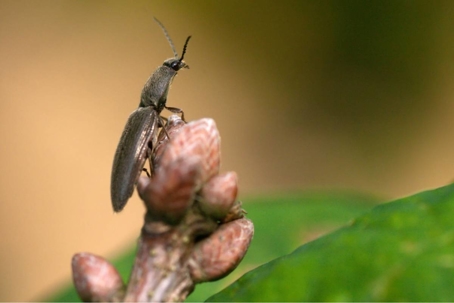Do Click Beetles Bite?
Click beetles are not considered biting insects. These beetles do not have mouthparts adapted to pierce human skin, and they generally feed on plant material, roots, or decaying matter rather than blood. Unlike biting pests such as mosquitoes, ticks, or bed bugs, click beetles do not seek out humans or animals to feed on.
The only scenarios where a “bite” might occur are very rare and incidental, such as:
Handling the beetle roughly: If a person grabs or squeezes a click beetle, it might try to defend itself by nibbling, but this is extremely uncommon.
Accidental contact with sensitive skin: Even if it did nibble, the mouthparts are weak, so any injury would be minor and not harmful.
In practical terms, click beetles are completely harmless to humans and pets, so there’s no typical situation where you’d need to worry about being bitten.
Click Beetle Bites
Click beetle bites pose virtually no risk to humans. Their mouthparts are not strong enough to pierce skin in any meaningful way, so any “bite” would be superficial at most. There are no known toxins or venom associated with click beetles, and they are not disease vectors, meaning they do not transmit infections or pathogens through biting.
In rare, incidental cases where a click beetle might try to nibble when handled:
You could experience minor skin irritation or a small scratch, similar to a mild pinprick.
Allergic reactions are theoretically possible but extremely uncommon, as click beetles are not a recognized allergen source.
The real risks from click beetles are to plants and crops, not humans. Their larvae, called wireworms, can damage roots and seedlings, which is why they are mainly a concern in agriculture or gardening rather than as a biting hazard.
What Do Click Beetle Bites Look Like?
A click beetle bite is extremely rare, but if it did occur, it would be very minor. Since their mouthparts are small and weak, the “bite” would likely appear as:
A tiny pinprick-like mark on the skin.
Slight redness or minor swelling, if any.
Minimal to no pain, possibly just a brief prick or tingling sensation.
No bleeding in most cases.
Click beetles do not inject venom or irritants, so the mark would not develop into a rash, blister, or infection under normal circumstances. Any irritation would generally disappear within a few hours.
For practical purposes, click beetle “bites” are so rare and minor that they are not a medical concern.
What To Do About Click Beetle Bites
If you were ever bitten by a click beetle—which is extremely unlikely—the steps are very simple because the risk is minimal:
Clean the area: Wash the bite with mild soap and warm water to remove any surface bacteria.
Apply a soothing agent: Use an over-the-counter antiseptic or a thin layer of antibiotic ointment if the skin is slightly broken.
Reduce irritation: If there is minor redness or itching, a cool compress or a dab of hydrocortisone cream can help.
Monitor for unusual reactions: Serious allergic reactions are extraordinarily rare, but watch for significant swelling, rash, or difficulty breathing. Seek medical attention immediately if any of these occur.
No further treatment is usually needed: Most click beetle bites, if they occur at all, heal quickly on their own.
In reality, you don’t need to worry about click beetles biting, and any concern is far more relevant for wireworm damage to plants than for human bites.

